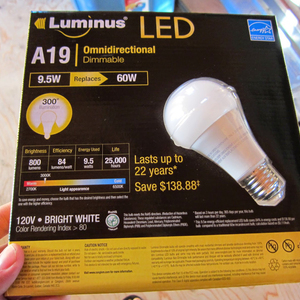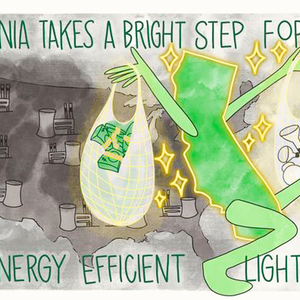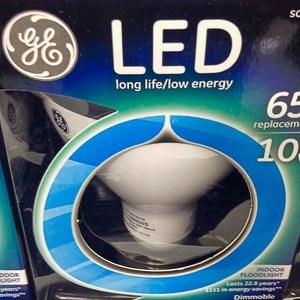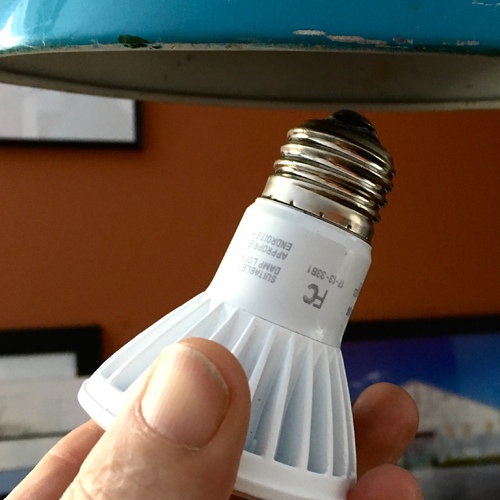
The Department of Energy has decided that certain light bulbs won’t have to show improved energy efficiency after all.
The department last week announced it intends to scrap plans for tougher efficiency rules that would have kicked in next year for a variety of bulb types, including reflector, globe-shaped, and candelabra lamps, according to a statement from the American Council for an Energy-Efficient Economy. The new efficiency standards were to be the second stage of a process approved by Congress in 2007.
The announcement won’t affect tougher standards for A-type lamps — the familiar pear-shaped bulbs used in many lamps and fixtures. Those will have to meet the 2020 efficiency minimum of 45 lumens per watt as originally outlined.
The planned expansion of efficiency rules would have extended efficiency requirements to bulbs that are now in nearly 3 billion light sockets in the U.S., the ACEEE said, and pushed incandescent versions of those lamps off the shelves.
The dispute hinges on a definition of a “general service lamp.” Officials decided in 2017 that the list should include reflector lamps, small candelabras, three-way bulbs, and the globe lamps used in bathroom fixtures. That would make them subject to the 45 lumen-per-watt limit next year. The industry fought the decision.
The proposed rule says that DOE has determined that the legal basis for adding those lamps to a list requiring higher efficiency “misconstrued existing law.” The department has scheduled a public meeting on February 28 to discuss the plan and will be taking public comments for 60 days. (You can attend the hearing via webinar by registering here.)
Critics cite cost to consumers, increased power use
Efficiency advocates blasted the plan and said it would cost consumers roughly $100 per year in added electricity costs while pushing up power consumption in the U.S. by 80 billion kWh per year. That’s the combined electricity use in all households in Pennsylvania and New Jersey. The move also would lead to more pollution from power plants.
Andrew deLaski, who heads the Appliance Standards Awareness Project, said in an analysis last year that the standards as originally written would have saved consumers about $22 billion in 2025. Total electricity savings would have exceed 140 billion kWh that year.
“The rollback sought by manufacturers would potentially eliminate all savings from the 2020 standards, slowing the transition to energy-efficient lighting and hurting consumers and the economy,” deLaski wrote.
Writing for the Natural Resources Defense Council, Noah Horowitz said the change would cost consumers as much as $12 billion on their utility bills and mean an additional 34 million tons of carbon dioxide emissions annually.
“DOE’s new proposal rolls back most of the definition that was previously updated in early 2017 by DOE under the Obama administration and needlessly provides a lifeline for the inefficient incandescent and halogen bulbs designed to go into 2.7 billion sockets — just under half of all conventional sockets in the United States — even though more energy-efficient models exist today,” Horowitz said in a blog.
Industry supports the change
The National Electrical Manufacturers Association, a trade group, said in a statement posted at its website that it had requested that the DOE review decisions it made in 2017 that would have broadened the definitions of bulbs to include a number of specialty types.
“NEMA argued that the inclusion of these specialty light bulbs in the definition of general service lamp was inconsistent with the text of the law and they were not ‘general service’ light bulbs,” the statement said. “Congress expressly stated these lamps were ‘not included’ in its definition of general service lamp.”
The group argued that the DOE plan is not actually rolling back any standards: “It is not legally possible to backslide from a point DOE could not legally stand upon in the first place,” it said. “To think otherwise would erode the rule of law and the primacy of Congress in establishing public policy.”
Also, NEMA said, consumers already get it and are switching to more efficient types of bulbs on their own. Shipments of general service LEDs topped compact fluorescent lamps and incandescent bulbs in the third quarter of 2017. By the third quarter of last year, LED lamps accounted for 65% of all general service shipments.
“NEMA estimates that approximately 75-77% of general service lamp sockets are occupied by general service LEDs and compact fluorescent lamps,” the statement said.
NEMA’s position is laid out in two blogs that review Congressional action on efficiency standards (they are available here and here). NEMA says that the 2017 rule adopted by DOE incorrectly applied to certain types of lamps.
“The DOE’s rule redefining general-service lamps was a regulatory expansion that relied upon an interpretation of Congress’s text that, in our view, can only be described as legally erroneous,” NEMA said.
Weekly Newsletter
Get building science and energy efficiency advice, plus special offers, in your inbox.















9 Comments
With the improvement of LED's over the years, I think they are here to stay. Can't see us going back to coal oil lamps.
With artificially low/subsidized energy prices, all kinds of market distorting laws are needed to encourage energy efficiency. The externalities need to be priced in.
45 lumens per watt seems like an awfully low target. When I buy bulbs today, I look for close to 100 lumens per watt, and settle at no less than about 80 lumens per watt.
For really tiny 40-80 lumen candelabra bulbs for chandeliers 45lm/w is more than just a stripe on the floor, but it's not a high hurdle either, especially if a bit of CRI can be sacrificed on the altar of efficiency (which is usually fine in that sort of application.)
But for anything 250 lumens & up 45 lm/watt is a very low bar indeed, even for R20/PAR20 reflectors or bathroom globes.
The bill that required more efficient light bulbs was enacted in 2007, as part of a large energy law approved by large majorities of the House and Senate and signed into law by President Bush. As is typical, the industries affected were instrumental in writing the law. 45 watts per lumen seemed, at the time, to represent a big improvement. Since then, technology has improved both the efficiency and light quality of led bulbs.
I suspect that the Trump Administration* gave little thought to energy efficiency and simply includes this proposal as part of its drive to reduce regulations , without regard to whether such reductions make any sense.
This isn't surprising given that the Department of Energy is run by a man who once campaigned to eliminate it. That is, if he could remember it...
https://youtu.be/mv9LBUG4KsE
Elections have consequences.
I'd like to see all the efficiency standards go away. They aren't needed and they take away choice in the market. Not all light bulb users want the light. Some want the heat. The subway ovens that cook your bread use incandescent bulbs--or at least they used to. I use incandescent bulbs to keep epoxy warm for my airplane project. Others use incandescent bulbs to cure carbon graphite parts. Why shouldn't they have a choice?
Consumers that want the most light per watt can certainly read a package and determine which product is best for them. When I shop for a light bulb (for light) I want the highest CRI. Efficiency is a secondary concern. The LED bulbs with the highest CRI tend to be less efficient than the crappy low-cost, low-CRI LED bulbs found in stores. Why shouldn't I have that choice?
If choosing to buy high or low efficiency light bulbs/appliances/whatever only affected the purchaser, then doing away with efficiency standards might be reasonable.
But since energy use contributes to global warming and other ecological issues that affect everyone (and affect future generations), energy efficiency standards seem like a good idea.
Without energy efficiency standards, there's an economic incentive to save money today at the expense of the climate that future generations will have to deal with.
The fact that incandescent light bulbs used for purposes other than lighting are collateral damage from the regulations seems to me an argument that perhaps the regulation should be more nuanced, not an argument that efficiency standards as a whole are a bad idea.
In Germany incandescent light bulbs are still sold, marketed as space heaters, often used as such in the poultry industry there. (I doubt the chickens care about CRI as much as they care about the heat- just a guess.)
Most consumers aren't that sophisticated, many (or even most) look primarily at first cost, not CRI, not lumens, not lumens per watt, not anticipated lifecycle or lifecycle cost. The same is true for refrigerators- efficiency and lifecycle cost are seldom analyzed by the buyers- the features and volume are primary. That's why it takes efficiency regulations to move these markets. I'm personally not much offended by the corresponding reduction in freedom of choice here. YMMV.
At a floor efficiency 45 lm/watt (or even twice that) it's possible to buy CRI 90+ bulbs in almost any form factor without having to steal from your kid's piggy bank. The cheapest incandescents don't have CRIs that high.
Log in or create an account to post a comment.
Sign up Log in